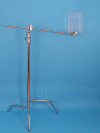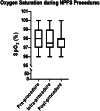Negative pressure face shield for flexible laryngoscopy in the COVID-19 era
- PMID: 32864444
- PMCID: PMC7444791
- DOI: 10.1002/lio2.437
Negative pressure face shield for flexible laryngoscopy in the COVID-19 era
Abstract
Objective: Introduce novel methods and materials to limit microdroplet spread when performing transnasal aerosol generating procedures in the COVID-19 era.
Methods: Prototypes of a negative pressure face shield (NPFS) were tested then used clinically to create a suction-clearing negative pressure microenvironment with controlled access to the nose and mouth. Air pressure measurements within prototypes were followed by prospective evaluation of 30 consecutive patients treated with the device assessed through questionnaires and monitoring oximetry.
Results: The NPFS is a transparent acrylic barrier with two anterior instrumentation ports and a side port to which continuous suction is applied. It is positioned on a stand and employs a disposable antimicrobial wrap to secure an enclosure around the head. This assembly was successfully used to complete transnasal laryngoscopy in all 30 patients studied. Tolerance of the design was excellent, with postprocedure questionnaire identifying no shortness of breath (27/30), no claustrophobia (27/30), no pain (29/30), and no significant changes in pulse oximetry.
Conclusion: Diagnostic laryngoscopy was successfully performed in a negative pressure microenvironment created to limit dispersion of aerosols. Further application of the NPFS device is targeted for use with transnasal laryngeal laser and biopsy procedures to be followed by additional modification to enable intranasal and intraoral procedures in a similar protected environment.
Level of evidence: Level 2b (Cohort Study).
Keywords: COVID‐19; diagnostic flexible; laryngoscopy; laryngoscopyaerosol generating procedure.
© 2020 The Authors. Laryngoscope Investigative Otolaryngology published by Wiley Periodicals LLC on behalf of The Triological Society.
Conflict of interest statement
Henry T. Hoffman: (a) COOK Medical: Research consultant and patent. (b) UpToDate: author. (c) IoataMotion: Research consultant with patent application. Coauthors Miller, Walsh, Stegall, and Diekema have no conflict of interest.
Figures











References
-
- AAO‐HNS COVID‐19 RESOURCES Guidance for return to practice for Otolaryngology‐Head and Neck Surgery. https://www.entnet.org/content/guidance-return-practice-otolaryngology-h.... Accessed June 21, 2020.
-
- Hoffman HT, ed. Iowa Head and Neck Protocols “Trans‐nasal laryngoscopy in COVID‐19 era—method for additional protection with disposable mask”. https://medicine.uiowa.edu/iowaprotocols/transnasal-laryngoscopy-covid-1.... Accessed May 3, 2020.
Grants and funding
LinkOut - more resources
Full Text Sources
Research Materials
